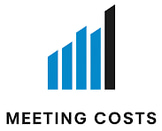The $399 Billion Meeting Tax: America's Silent Productivity Killer
Discover how unproductive meetings cost American businesses $399 billion annually and how your company can reclaim millions in lost productivity. Learn actionable strategies from industry leaders like Shopify and Meta that cut meeting waste by up to 30% while boosting innovation and employee satisfaction. Get practical tools to calculate your organization's meeting expenses and implement a proven meeting efficiency program that transforms wasted time into competitive advantage.
C.Carnoli
1/6/202510 min read
Unproductive meetings are costing American businesses billions. Each year, U.S. companies lose about $399 billion to meetings that don't achieve their goals. For a company with 100 employees making $60,000 a year, wasted meeting time could cost over $2.5 million a year.
This hidden cost isn't just about money—it's a crisis of productivity. The average employee spends 31 hours a month in meetings that don't help. This adds up to 372 hours lost each year—almost two months of work.
Harvard Business Review found that 70% of meetings actually stop employees from doing their work. After the pandemic, meetings got shorter by 20%, but more people attended them by 13.5%. Companies now face a problem—more meetings, but they're not solving the cost of unproductive meetings. The unproductive meetings impact on businessgoes beyond money: it leads to disengagement, higher turnover, and missed deadlines.
Key Takeaways
U.S. businesses lose $399 billion annually to unproductive meetings.
A 100-employee company wastes up to $2.5 million yearly in wasted meeting time.
Employees lose nearly two months of work time annually to unproductive meetings.
Post-pandemic, meetings are 20% shorter but 13.5% more frequent, deepening inefficiency.
70% of meetings actively hinder employee productivity (Harvard Business Review).
The Surprising Scope of Meeting Inefficiency in American Businesses
Meetings that don't produce anything waste time and money. In the U.S., businesses lose $37 billion each year because of bad meetings. Let's look at how too many meetings affect work across the country.
Current Statistics on Meeting Frequency Across Industries
Meetings vary by job and field. Today, executives spend 23 hours a week in meetings, up from 1960s levels. Here's a closer look:
65% of managers say meetings block their work
71% call meetings “unproductive or inefficient”
62% feel meetings miss team-building opportunities
The Average Time American Professionals Spend in Meetings
On average, employees spend 6 hours a week in meetings, with half of that time wasted. Key facts:
Post-Pandemic Shifts in Meeting Culture
Remote work changed meetings. Sessions are 20% shorter, but people often multitask or tune out. Key changes:
13.5% more meetings held since 2020
54% of workers say meetings disrupt productivity
“Meeting fatigue” now ranks among top workplace stressors
“Meetings that lack agendas waste up to 50% of workdays.” – Harvard Business Review
These trends show how unproductive meetings hurt focus and creativity. Next, we'll explore the financial impact.
Recent Study Reveals the True Cost of Unproductive Meetings
Studies show how much unproductive meetings cost businesses. The Queen Schools of Business found U.S. companies lose $399 billion yearly. Atlassian's research shows employees spend 31 hours monthly in meetings they don't need. This shows how meetings that don't help can hurt business, wasting resources and slowing things down.
37% of workers report disengagement linked to excessive meetings.
Unnecessary meetings account for 30% of total meeting time.
Large firms waste up to $101 million annually on unproductive sessions.
Start by tracking time and salaries lost in unproductive meetings. For example, a company with 5,000 employees could save $101 million yearly by cutting out unnecessary meetings. Gallup found teams that are not engaged are 18% less productive. This shows how meetings that don't help can hurt a business's health.
Companies like Xerox spent over $100 million a year on meetings before making changes. These numbers highlight the need for better ways to track and cut down on wasted time and money.
Breaking Down the Financial Impact of Meeting Waste
Meetings that don't produce anything cost a lot more than just the people's time. Start by calculating meeting expenses to see the real damage. For example, a 10-person meeting for an hour costs $500 just in labor. If each person makes $50 an hour, that's a lot of money.
For weekly meetings, the yearly loss for the same group is $26,000. Big companies face even bigger losses. A company with 5,000 employees could waste over $100 million a year on bad meetings.
"Meetings that fail to set agendas waste 31% of work hours," warns the Harvard Business Review, linking disorganization to lost productivity.
High-paid employees attending meetings also add to the cost. A manager making $100 an hour in a 2-hour meeting costs $200. With 15 people, that's $3,000 for just one meeting. Over time, these costs add up to hundreds of thousands of dollars.
Using cost-effective meeting strategies like time limits and strict attendee lists can help save money.
Meetings also mean lost opportunities. Time spent in meetings is time not spent on making money. Employees lose about 6 hours a week in meetings. That's time that could be used to make deals, innovate, or serve customers.
Delays in projects because of bad meetings also cost time and money. For tech companies, being late to market can cost millions of dollars.
Wasting time in meetings also hurts morale and innovation in the long run. Teams that spend too much time in meetings lose focus on important goals. Companies like Intel and Google have cut their meeting times by 20% by using cost-effective meeting strategies.
These changes have freed up 15% of work hours each year. This has boosted innovation and helped deliver better to clients.
The Hidden Psychological Toll of Ineffective Meetings
Unproductive meetings hurt businesses more than just their wallets. They drain employees' minds with endless, unfocused meetings. Studies show 71% of meetings don't meet their goals, leaving workers exhausted.
Gallup found teams that are not engaged are 37% more likely to miss work and 18% less productive. This isn't just stress—it's a cycle that harms morale and output.
Meeting fatigue is clear: cameras stay off, ideas are ignored, and people multitask. Over 64% of workers say meetings are their biggest daily drain. Even remote workers feel the burn: 40% report mental exhaustion from video calls.
“Unproductive meetings waste up to $37 billion annually in the U.S.” — Harvard Business Review
Signs of burnout include:
Repeated delays in decision-making
Rising absenteeism and presenteeism (showing up but underperforming)
Increased errors costing time and resources
There are ways to make meetings better. Companies like Shopify keep meetings short, at 25 minutes. Meta has days without meetings to boost focus. Simple steps like clear agendas can save time.
Regular checks on meetings ensure they're worth the time.
Ignoring this toll risks losing talent and innovation. Teams need strategies that make meetings productive, not draining.
How to Calculate Your Organization's Meeting Expenses
Meetings that don't add value can waste a lot of money. But, by calculating meeting expenses accurately, leaders can make better use of their resources. Here's how to turn meeting costs into useful data.
Start with a simple formula: Hourly cost = (Annual salary ÷ 2080 work hours) × (1 + benefits percentage). Then, multiply this by the total meeting hours and the number of attendees. For example, a 1-hour weekly meeting with 10 employees making $60k a year costs $1,560 a year, including benefits.
Meeting TypeAverage Cost FactorsOptimizing TipsWeekly Team Syncs10 attendees × $65/hour = $650/monthShorten to 25 mins, reduce frequencyExecutive Strategy Sessions5 high-level execs × $150/hour = $750/hourRequire pre-read materials to cut discussion timeCross-Department Reviews15+ participants × $78/hour = $1,170/hourUse asynchronous updates instead of full-group sessions
Use these metrics to track your progress:
Monthly meeting hours per employee
Cost per decision made
Employee engagement scores post-meeting
Tools like Fellow can cut meeting time by 16%, saving $7k per manager each year. Update your calculations regularly using this optimizing meeting resources framework. This will help you find ways to save money. Adjust your approach based on your organization's specific needs and goals.
Case Studies: Companies Transforming Their Meeting Culture
Top companies are changing how they work together by improving meeting efficiency. They use meeting productivity solutions to cut down on waste. This lets them focus more on innovation.
Shopify got rid of 12,000 meetings, saving 36 years of time each year. They set meetings to last 25 minutes and limited who could attend. This freed up 1,200+ hours for deep work, saving about $8.4 million.
Meta and Canva started "no-meeting days" to help people work without interruptions. A study from MIT Sloan found this made teams more engaged and autonomous. Teams now have 30% fewer unproductive calls and are 20% happier.
These companies follow research that says 65% of managers see meetings as a problem. By making meetings shorter and more focused, they get more done. Shopify shows that cutting out unnecessary meetings can really help focus on what's important.
Starting to change how you meet begins with checking your meeting schedule. Companies like Asana use data to find meetings that aren't needed. They then use tools that let people work together without meetings. This leads to fewer distractions, happier teams, and a better work culture.
Proven Strategies to Reduce the Cost of Unproductive Meetings
Companies like Tesla and Apple cut down on reducing meeting costs by taking bold steps. They start by setting clear rules and making sure everyone is accountable. Here's how to make these ideas work:
Implementing a Company-Wide Meeting Policy
Follow Elon Musk's rule: “No large meetings unless of clear value to all attendees.” Make policies that require agendas, limit meeting times (like 50 minutes), and let people choose if they need to be there. Buffer's "two-pizza rule" helps keep groups small and focused. With 55 million meetings happening every day, it's time for a big change, not just small fixes.
“No Agenda, No Meeting” Enforcement
Make sure every meeting has a clear agenda. Steve Jobs made sure each item had a Directly Responsible Individual (DRI)to keep things on track. This cut down meetings by 30%. Use templates to make sure everyone knows what to expect.
Optimizing Duration and Attendance
Keep meetings short, 35-50 minutes, to avoid burnout.
Make sure someone is in charge of starting and ending meetings.
Use labels for optional attendance to save money.
Alternative Communication Methods
Replace half of your meetings with tools that let people communicate on their own time. Gartner says this can make you 18% more productive. Use Slack channels, emails, or decision trees for simple topics. Buffer saves 16 minutes a day for each employee this way.
“Meetings are only useful if they’re necessary,” says Musk. “If not, replace them with clear action items.”
These methods aren't just ideas—they're proven ways to save money and spark new ideas. Start by checking how many meetings you have and apply these tips right away.
Technology Solutions for Streamlining Collaboration
Modern meeting productivity solutions solve common problems. Tools like improving meeting efficiency by automating tasks save a lot of time. Here are some ways to pick the right tech for your team:
Tools like Loom’s video updates or Slack’s threaded discussions make regular meetings unnecessary. For instance, Flowtrace’s analytics help spot overbooked calendars. AI transcriptions also reduce the time needed for taking notes after meetings.
A 2023 Harvard study showed teams using these tools cut meeting time by 22%. Yet, they didn’t lose any productivity.
Choose platforms with integrations (e.g., Slack + Asana) to streamline workflows
Focus on tools with analytics dashboards to track time saved
Try free trials of tools like Miro’s whiteboard for remote brainstorming
Even small changes can make a big difference. For example, switching from 3-hour strategy sessions to a 15-minute Loom video can save 2.75 hours a week for each employee. For teams across the globe, video conferencing platforms like Zoom cut travel costs while keeping everyone connected.
Implementing a Meeting Efficiency Program in Your Organization
Changing how meetings work starts with a clear plan. Companies like Microsoft and Google cut down on meetings by 20%. Here's how to start:
“Lead by example, rigorously applying these principles to your own meetings.”
Secure Leadership Support
Share facts: Unproductive meetings cost U.S. businesses $399 billion a year (Doodle study).
Explain how optimizing meeting resources helps meet goals like saving money and being more innovative.
Use examples: Intel reduced meeting time by 15% with clear plans.
Train Facilitators
Teach managers to lead focused talks. Training should include:
How to make agendas and manage time
Assigning roles to participants
Using tools like Flowtrace for quick feedback
Measure and Adjust
Keep track of how well things are going with:
Weekly checks on meeting results
Surveys to hear what employees think
Looking at money saved, like hours turned into dollars
Connect meeting success to how well you do your job. Teams that work on improving meeting efficiency make decisions 30% faster (Harvard Business Review).
Begin with one team. Then, roll it out everywhere. Celebrate the small wins to keep everyone excited.
Conclusion: Turning Meeting Costs into Productivity Gains
Meetings that don't achieve their goals cost U.S. businesses $37 billion each year. This waste of time—24 billion hours annually—hurts budgets and morale. But, there are ways to make these hours count.
Start by taking steps to reduce meeting costs. Limit meetings to 30 minutes, as suggested by the University of North Carolina. Use tools like ActivTrak’s analytics platform, which 9,500+ organizations rely on.
Tools like Slack and Trello help make quick decisions. Having a clear agenda can also cut down on unnecessary meetings. Companies like Bain & Company focus on the strategic value of each meeting.
By tracking how well tasks are completed and post-meeting engagement, teams can spot where they're wasting time. Small changes, like requiring clear agendas or digital updates instead of meetings, can make a big difference. Harvard Business Review found that over two-thirds of meetings lack purpose. But, changing how we approach meetings can change company culture.
Companies that focus on reducing meeting costs through better policies and technology see real benefits. By focusing on outcomes over tradition, we can turn wasted time into innovation. Start with one change: shorten meetings, review agendas, or train leaders. The result? A workplace where teamwork drives success, not hinders it.
FAQ
What are the financial implications of unproductive meetings?
Unproductive meetings cost businesses billions of dollars each year. This loss comes from wasted time, salaries paid for nothing, and missed chances for real work.
How can organizations calculate the cost of unproductive meetings?
Businesses can figure out the cost by multiplying the salary per minute of attendees by the meeting time. They should also look at what they could have done instead, to see the full cost.
What role does meeting frequency play in organizational productivity?
Too many meetings can make employees tired and less productive. It also means important tasks get pushed back because of all the meetings.
What strategies can organizations implement to improve meeting efficiency?
Companies can make a meeting policy, stick to the "No Agenda, No Meeting" rule, and make meetings shorter and more focused. They can also use other ways to talk that don't need a meeting.
How has the pandemic affected meeting culture?
The pandemic made meetings shorter by 20% but more frequent by 13.5%. Virtual meetings have caused fatigue, stress, and lower job happiness for employees.
What are some technological solutions to streamline meetings?
Tools like meeting management platforms, software for talking without meetings, and AI helpers can make meetings better. They help cut down on bad meetings and make work more efficient.
Why is it important to address meeting inefficiencies?
Fixing bad meetings is key for a company's money and happiness. Better meetings mean more done, less waste, and a better work place.
What can be learned from organisations that have successfully transformed their meeting culture?
Companies that cut down on bad meetings did it by focusing, being accountable, and checking if meetings really help. This shows it's possible to make meetings work better.
How do ineffective meetings impact employee morale?
Bad meetings make employees unhappy, stressed, and tired. This can lead to them not wanting to work there anymore, which hurts the whole team.






Connect
Get in touch for meeting cost solutions.
Resources
© 2025. All rights reserved.
